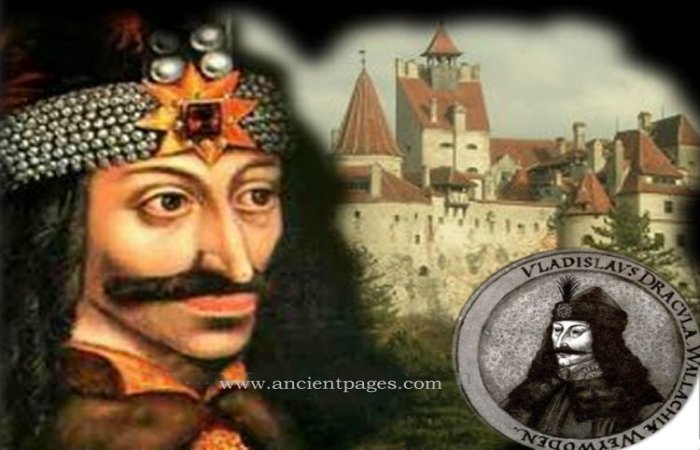A. Sutherland – AncientPages.com – No doubt, the most famous and intriguing Romanian figure in both history and fiction is Vlad Țepeș (Dracula). Behind Dracula’s renowned name is also the extraordinary life and times of the evil Romanian ruler from 1431 to 1476. His nickname is the Impaler.

Vlad used severe methods to restore order in a lawless state. He also had the courage to drive the occupation force, the Ottomans out of the country. But Vlad had a dark side… too.
He was regarded with great fear in many regions of Europe and Asia in the fifteenth century and strived to equal by many later rulers like, for example, Ivan the Terrible; Dracula did, in fact, exist.
He was also highly honored by his fellow citizens and is still even today.
However, he was not a bloodthirsty vampire but a Prince in Wallachia, a part of present-day southern Romania.
Vlad lived in Romania among many rulers and historical figures, surrounded by prejudices and controversies in the atmosphere of betrayal, conquest, and imprisonment.
As the author writes in “Captivating History; History of Romania, “the greatness of historic individuals cannot be measured through the prism of the modern age. To fully understand the actions and motivations of Vlad Tepes, Stephen the Great, and Michael the Brave, we have to understand that Romania was positioned between the Ottoman Empire and Europe, between the traditional East and the modern West. Just as the world was torn between the great powers, so were the rulers of Romania..”
Vlad Tepes (the Impaler)
His real name was Vlad III, but he was often called Dracula. Romania is full of ancient tales of the supernatural and legends of the unexplained, which have long influenced our imagination.
The Irish author Bram Stoker likely borrowed Vlad’s name for his Transylvanian count in the book “Dracula” from 1897. We must remember that ‘Dracula’ is translated in Gaelic as Drac Ullah, which means ‘bad blood.’
Vlad lived between 1431 and 1476 and is regarded as a national hero in his home country. He was considered a brutal and yet fair ruler.
During the 15th century, there was a struggle to obtain control of Wallachia, a region of the Balkans (Romania) that lay directly between the two powerful forces of Hungary and the Ottoman Empire. The power of the Ottomans seemed unstoppable.
Vlad used severe methods to restore order in a lawless state. He also dared to drive the occupation force, the Ottomans, out of the country. But Vlad had a dark side, too. He was delighted in torture and executions.
He was famous for slowly driving a pole through the bodies of his enemies while they were still alive. Vlad was a ruthless man, and his “methods” were brutal. Impalement was and is one of the most gruesome ways of dying.
His enemies feared Dracula, and he was called Tepes, meaning the Impaler.
It often took hours, sometimes even days, before the poor victim died on the pole. Later, the pole and the victim’s body were publicly displayed. This horrifying sight was meant to serve as a warning to all Ottomans as well as different types of criminals, like thieves, murderers, and others.
The origin of the name Dracula has yet to be entirely confirmed. “Drac” means “devil” in the Romanian language and the ending “-uela” means “son of.” We can ᴀssume that Vlad’s nickname was “Son of the Devil.”
Still, we must remember another essential aspect related to the origin of Vlad’s name.
In 1431, Vlad’s father was a member of the Order of the Dragon, a secret order of knights meant to protect the royal family from the invading Ottoman Turks.
The dragon was considered a symbol of the devil. Therefore, Vlad’s name means “Son of the Dragon” or “Son of the Devil.”
It is unknown why Bram Stoker used the name Dracula in his book, but there are two theories.
In 1890, Stoker borrowed the book “An Account of the Principalities of Wallachia and Moldavia,” written 1820 by William Wilkinson. This book contains many descriptions of Dracula’s life. Perhaps Stoker used this book as a source and inspiration for his novel.
Another possibility is that Stoker learned about Dracula through his friend Professor Arminius Vambery, whom he visited on several occasions in Budapest. Stoker mixed the history of Dracula’s life with folktales of vampires, resulting in a classical book that is popular until today.
Dracula was a cruel, ruthless, and bloodthirsty ruler, but he was not a vampire. He is considered a national symbol of the fight for independence against the Ottomans in Romania.
Written by A. Sutherland – AncientPages.com Senior Staff Writer
Updated on Sep 10, 2023
Copyright © AncientPages.com All rights reserved. This material may not be published, broadcast, rewritten or redistributed in whole or part without the express written permission of AncientPages.com
Expand for references
References:
Keith Hitchins, A Concise History of Romania
Raymond T. McNally (Author), Radu R Florescu (Author), Dracula, Prince of Many Faces, 1990
Captivating History, History of Romania





